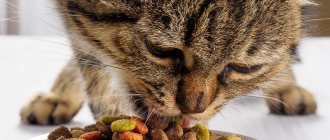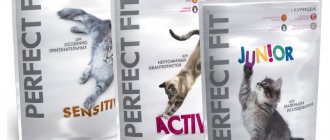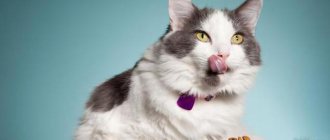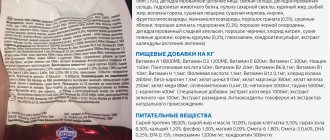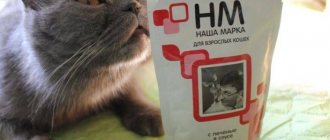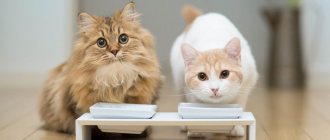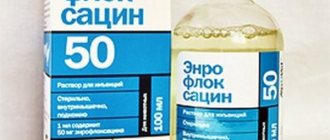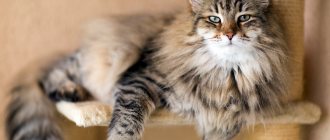Allergies have become a problem not only for humanity, but also for animals. Quite often this pathology occurs in cats. An allergic reaction is considered a very complex process that is provoked by various factors.
Allergy is a hypersensitivity of the immune system of the human or animal body, provoked by repeated exposure to allergens. In some cases, the body is able to remember an absolutely safe substance (allergen) and react to its influence again as if it were dangerous. When the rejection mechanism is activated, an allergic reaction begins.
Signs of an allergic reaction in cats
Allergies in cats, like in people, are provoked by various allergens; this reaction of the body has its own unique symptoms.
Allergy in a cat is manifested by the following symptoms:
- scratching on the dermis;
- skin redness;
- blisters;
- hair loss;
- papules;
- itching;
- vomit;
- nasal discharge;
- diarrhea;
- otitis;
- eczema.
The above signs of an allergic reaction can appear either individually or in combination. The severity of allergies does not depend on the amount of allergen that has entered the body. Even a small amount of an irritating factor can provoke an atypical reaction in a pet’s body.
Symptoms of food allergy in kittens and adult cats
The severity and intensity of symptoms characteristic of allergies depends on age, physiological, individual characteristics of the body, resistance, and the degree of exposure to allergenic substances.
The signs and symptoms of food allergies are similar in many ways to other types of allergies. It should be understood that itching, lacrimation, and indigestion can be caused by viral, bacterial infections, helminthic infestations, systemic diseases and pathologies. An accurate diagnosis can only be made by a veterinarian after a comprehensive diagnosis.
The main signs and symptoms of nutritional allergies in kittens and adult cats:
- severe itching, the appearance of dandruff, hairless areas, bald spots on the body (muzzle, in the ear area, on the sides, chest, abdomen);
- lacrimation, mucous and mucopurulent discharge from the eyes and nose;
- swelling of the eyelids, dry crusts in the corners of the eyes;
- poor condition of the coat (matte, faded coat);
- excessive sweating;
- inappropriate behavior (lethargy, depression, apathy, drowsiness;
- increased thirst;
- frequent sneezing, dry cough;
- difficult or frequent bowel movements and urination;
- unpleasant odor from the mouth;
- flatulence, bloating;
- pallor, hyperemia of mucous membranes;
- white or gray coating on the tongue;
- darkening of the skin;
- inflammation of the ears;
- swelling on the body.
The main symptoms of food allergies are presented in the following photos:
Hair loss in a cat
Redness on a cat's skin
Allergy symptoms on a cat's face
If you have an allergy, your fur will fall out in clumps.
Food allergies in cats, in addition to the symptoms listed above, can manifest themselves in the form of digestive tract disorders. Cats suffer from nausea, vomiting, diarrhea, alternating with constipation. Pets refuse food and offered treats, become inactive and lethargic.
In advanced cases, cats have a complete loss of appetite, multiple scratches, scratches, bleeding ulcers, long-lasting wounds, and ulcers appear on the body.
If a cat's food allergy manifests itself in an acute form, then the general temperature may increase by one or two degrees. If the cat shakes its head, there is a large amount of wax in the ears, there is a dark brown coating, dry crusts, scabs, then these symptoms may also indicate the development of allergies, including food allergies.
Before you begin treatment for nutritional allergies, you need to establish the root cause and determine which products lead to allergic reactions. It is also worth noting that many owners mistake intolerance to certain foods that are present in the cat’s diet for an allergy. Therefore, it is very difficult to make an accurate diagnosis on your own.
Diagnostics involves a number of tests and sensitivity tests. The veterinarian takes into account medical history, characteristic clinical symptoms, and conducts a comprehensive examination of four-fingered patients.
Features of food allergies
Food allergies in cats are considered a fairly common type of atypical reaction in a pet. It accounts for about 10% of all cases of allergies in cats. It is at the third stage after a reaction to flea saliva, atopy (inhalation allergy).
Experts have not yet sufficiently studied the features of the processes in the gastrointestinal tract of cats that cause an atypical reaction of the body to certain food allergens. Although the disease process is still not fully understood, veterinarians have already identified the symptoms of food allergy in cats into a separate group, which we will consider below.
Allergic reactions in pets develop to the foods they most often consume. There is no definite connection between the breed, sex of the animal and the tendency to allergies, as is the case with atopy.
The first symptoms of an atypical reaction of the body to food can appear from five months. But most often the pathology is recorded in adult cats (2 – 6 years old). Along with food allergies, inhalation and contact allergies can develop.
It is very important to distinguish between diseases such as food allergies and food intolerances. In the first case, the pet has problems with the dermis and itching.
In the second case, there are no typical signs of allergies, but there is an upset stomach and diarrhea. You can avoid unpleasant conditions by eliminating foods that provoke illness from your cat’s diet.
Allergy to food in cats: when does this phenomenon occur?
The immune system, having encountered a substance that is actually safe, may perceive it as a threat. Then the inflammatory process, which we call allergy, starts. A reaction to food occurs in cases where the cat’s body has detected allergens in the composition.
Allergy to natural food
In most cases, the cause of allergies is protein. Moreover, a reaction to beef or chicken can take a very long time to develop; the allergen will accumulate in the body throughout the year. Eggs, fish and wheat can also cause food allergies.
Allergy to dry food
Allergies most often develop to dry food. It contains many chemical additives, dyes, and flavor enhancers. It contains a high concentration of animal protein, so susceptibility can appear even to expensive and high-quality food.
This allergy develops very quickly, which means it is detected at a fairly early age of the kitten.
Allergy to wet food
Wet food is the least allergenic. It contains a lot of water, which means that fewer irritants enter the body. Allergies to wet food develop more gradually than to dry or natural food. The onset of symptoms is less severe, and it may take a long time before the owner discovers that something is wrong with the animal.
Why do food allergies occur?
According to studies, some foods are more likely to provoke an atypical reaction in the body than others. The most common causes of food allergies in cats are:
- dairy products;
- mutton;
- soy;
- wheat gluten;
- corn;
- chicken;
- beef.
These foods are usually included in a cat's diet. Experts associate the frequency of an allergic reaction with the amount and duration of exposure to certain proteins.
Diet for illness
Different diets are used for the animal. Nutrition is introduced based on ingredients that the animal has not tried before. These are feeds containing hydrolyzed protein, which undergoes a special fermentation process that destroys polypeptide chains. The proteins obtained in this way do not cause allergies in the animal.
Food allergies can affect cats at any age, but most often occur in young cats. Symptoms of food reactions occur year-round, so they are not seasonal, as is the case with other allergies. Most often, animals develop abnormal immune responses to proteins in their diet. It can be protein of both animal and plant origin.
Scientific research has shown that the most common allergens in animals are:
- beef;
- Domestic bird;
- mutton;
- milk;
- eggs;
- wheat, soybeans, corn and rice.
In addition to protein, carbohydrates contained in food can also cause allergies.
Symptoms of food allergies
Food allergies in pets show the same symptoms as other types of allergic reactions. The main one is itching of the dermis. May also be present:
- miliary dermatitis;
- combing;
- hair loss.
Based on physical signs alone, it is fairly easy to differentiate a food allergy from atopy, another type of allergic reaction. In the first case, signs of pathology appear in winter, all year round. A peculiarity of the condition is the nuance that even steroid medications cannot remove the unbearable itching of the dermis.
When examining a cat, the veterinarian will pay attention first of all to the rash. It may initially be local. Then it spreads. The rash can cover large areas of the body. Over time, the rash can develop into allergic dermatitis. In this case, we should talk about the addition of a bacterial infection.
The second symptom that your veterinarian won't miss is itching. Cat allergies rarely occur without itching. Typically cats scratch the following parts of the body:
- ears;
- tail root;
- back.
The cause of itching is the production of biologically active substances (the body's response to the penetration of an allergen). Due to constant itching, the animal can damage the dermis, causing a secondary infection.
One of the signs of an allergy is redness of the dermis in the area of the ears and auricles. The cat begins to comb them. This can cause the appearance of otohematoma (accumulation of blood under the dermis of the auricle). Bald patches and severe hair loss may also occur. It is easiest to notice redness in hairless breeds of cats (bambino, sphinx). These breeds are considered to be highly allergic. After redness, the pet may experience dandruff and peeling of the dermis. Signs such as discharge from the nose and eyes may also indicate the presence of an allergic reaction.
You need to pay attention to the following characteristic signs of allergies in your pet:
- vomit;
- diarrhea;
- snore. The cause of this symptom is swelling of the nasal mucosa, difficulty passing air through the nose during sleep.
Popular manufacturers
Competition in the market and the struggle for each customer encourage companies to expand their range, which is why many brands have diets for pets with food intolerance. Not all of them are created equal: there are products in this segment that are of higher quality than others. We have compiled a list of the most famous, as well as less popular, but worthy of attention brands.
Royal Canin
A French company whose category of veterinary diets includes two types of hypoallergenic cat food: Royal Canin Hypoallergenic DR25 and Anallergenic. In this case, this is not a marketing ploy at all, but two different recipes:
- Hypoallergenic DR25 contains hydrolyzed soy proteins and rice, plus a complex of prebiotics and components to improve skin condition.
- Anallergenic is a diet based on hydrolyzed feather meal and pure corn starch. Includes antioxidants and a number of excipients that protect the skin from dryness.
More about Royal Canin food
ProPlan
HA Hypoallergenic is a dietary diet from the medicinal line of this brand. It is suitable for the role of an exclusion diet, since it contains only one source of protein (soy, hydrolyzed) and highly refined carbohydrates (rice starch). To completely eliminate all symptoms of the disease, it is recommended to use it for 8-10 weeks.
Read more about ProPlan feeds
Hill's
Prescription Diet z/d is a therapeutic food for cats from a brand known even overseas. Helps reduce negative reactions, both from digestion and the skin associated with eating food. The main components in its recipe are rice and animal protein, which has undergone a deep processing process - hydrolysis, which reduces the risk of the immune system responding to this product to a minimum.
1st Choice
The Canadian manufacturer's Hypoallergenic formula will be relevant for cats with hypersensitivity to traditional proteins in food. This product is based on duck meat and sweet potatoes, and is completely grain-free. Intended for animals aged 1 year and older.
Learn more about 1st Choice food
Farmina
UltraHypo is a food from the Vet Life veterinary series of a popular Italian company. The basis of the recipe is hydrolyzed fish protein and refined rice starch; the source of lipids is fish oil. The composition includes natural antioxidants, prebiotics, chelated minerals and vitamins.
More about Farmina food
Sanabelle
A line of food for cats from the German company Bosch-Tiernahrung, which contains the Sensitive diet, designed to help pets with food intolerance. Contains poultry and lamb, as well as rice, sorghum and potato protein. Free of soy, wheat and synthetic preservatives, dyes, flavor enhancers and GMOs.
Read more about Sanabelle food
Monge
An Italian brand that also produces medical nutrition for animals is Monge Vetsolution. Their Dermatosis Diet is a super premium hypoallergenic cat food that is grain and gluten free. The main ingredients are hydrolyzed salmon protein, tapioca, potato and freeze-dried chicken.
More information about Monge food
Acana
A Canadian brand that stands out from most products with its consistently excellent composition and high quality products. These menus are suitable for pets who cannot digest gluten, as they do not contain grains. The sources of animal protein in the recipes are mainly lamb, duck, turkey, fish, as well as chicken and chicken eggs. For those who cannot tolerate eggs or chicken, there is an all-fish diet, Acana Pacifica.
Read more about Acana food
Orijen
A line of diets from the authors of Akana. They also do not contain grains or potatoes, which means that the body’s reaction to gluten is eliminated, plus a larger amount of meat ingredients. For digestive disorders associated with animal protein, you can pay attention to the menu of six types of fish (Six Fish), as well as the Tundra formula with rare, atypical animal proteins (goat, duck, venison, wild boar and fish).
Read more about Orijen food
Leonardo
These are recipes created in Germany by a team of Bewital specialists. For pets prone to negative reactions to food, special diets have been developed with amaranth instead of grains and chia seeds to support digestion - on poultry or fish (Poultry GF, Salmon GF and Maxi GF). There is also a diet based on lamb meat and rice - Leonardo Adult Lamb.
Read more about Leonardo food
Pronature Holistic
High-quality Canadian nutrition, made only from natural ingredients of organic origin. There is no place for corn, soy and wheat in the diets of this brand, as well as for chemical additives, GMOs and dyes. To improve intestinal transit and optimal absorption of food, the manufacturer offers menu types based on salmon and brown rice, duck and orange, turkey and cranberry, as well as white fish and wild rice.
Learn more about Pronature foods
Brit Care
Czech made cat food. The company positions the entire Brit Care line as hypoallergenic, probably due to the abandonment of wheat, soy and corn in favor of rice in most formulations. However, they do have a grain-free diet, Sensitive Digestion, based on lamb, salmon and dried potatoes, designed specifically for pets with sensitive stomachs.
More information about Brit Care foods
Canagan
The brand comes from the UK, the entire range of which is grain-free, high-quality recipes that guarantee the absence of a negative body response to gluten. And for those who don’t eat chicken, there is the Country Game formula - with duck, venison and rabbit, as well as Scottish Salmon - with salmon, herring and trout.
More information about Canagan food
Go!
This is one of the trademarks of Petcurean, Canada. To overcome the difficulties associated with cats' aversion to certain foods, they created the Sensitivity+Shine line. It includes two grain-free diets: Freshwater Trout & Salmon (with trout, salmon and herring) and Limited Ingredient Duck (duck meat as the only source of protein). These menus are rich in healthy Omega acids, taurine, pro- and prebiotics, they are suitable for both adults and kittens.
Learn more about Go!
Now Fresh
Another brand from Petcurean, creators of Go! Its fundamental difference from its brother is that Now uses only fresh raw meat, not dehydrated. For individuals with sensitive digestion, Now Fresh Fish food is recommended, with trout and potatoes as the main ingredients.
Read more about Now Fresh food
All the foods described above belong to different price categories and have significant differences in their composition. When choosing food for your cat, you should first of all be based on the ingredients, and only then on the popularity of a particular brand.
Allergic reaction to chicken
Very often, cats develop an allergy to chicken. This is explained by the fact that this ingredient is used in the manufacture of many pet foods. Once you have diagnosed an allergic reaction, it is very important to change your pet’s diet. If the cat eats natural food, you simply exclude chicken from the menu.
If you give your cat special food, choose the treat carefully. You can try giving him Orijen (with fish), Hills, Proplan (with lamb, fish). There are also special foods made specifically for allergy sufferers. They do not contain any components that provoke an allergic reaction in cats.
Hypoallergenic cat food: review
Any veterinarian, felinologist or cat breeder will tell you that there is no “same” ideal food that will suit a particular cat. The selection of food is carried out using a trial method, so for the first time it is recommended to buy the smallest packs of food so as not to lose money if the cat reacts negatively. Below we present the best hypoallergenic foods, based on reviews from veterinarians and cat owners.
Table. The Best Cat Foods Labeled "Hypoallergenic"
| Name, brand | Main ingredients included | Description | approximate cost |
"Proplan" Veterinary Diet HA Hypoallergenic | Rice starch, hydrolyzed soy protein, animal and fish oil | Veterinary diet that excludes allergenic ingredients. Eliminates skin problems, itching, scratching, bloating, gas formation, gastrointestinal problems | 1200 rubles per package of 1.3 kilograms |
Hill's Prescription Diet Food Sensitivities | Rice, rice protein, chicken liver | Recommended for cats with food intolerance or nutritional allergies. The components of the food have a beneficial effect on the body of an allergic cat, eliminating symptoms and ailments such as itchy skin, otitis media, and intestinal inflammation. | 1900 rubles for a package of 2 kilograms |
Farmina Natural&Delicious Cat Grain Free Pumpkin Duck grain-free | Fresh duck meat, pumpkin, herring, dried carrots | Prevention of diabetes, maintaining the immune system, cleansing the body of carcinogens, protecting the vascular and cardiac systems, anti-inflammatory, regulatory effect | 1500 rubles per package of 1.5 kilograms |
Royal Canin Hypoallergenic DR25 Feline | Poultry liver, rice, fiber, soy protein isolate | Supports the protective functions of the skin and coat, reduces allergic reactions, rashes, itching, ensures the integrity of the intestinal mucosa, supports microflora | 2000 rubles for a package of 2 kilograms |
"Acana" Pacifica Cat | Herring, sardine, flounder, hake, sea bass, cranberries, seaweed | Reduces the pH of cat urine, removes toxins from the intestines, nourishes and tones the digestive tract due to phytocomponents. Well absorbed, keeps skin and coat in perfect condition | 1,700 rubles per package of 1.8 kilograms |
"Golden Eagle" Sensitive Cat | Chicken, potatoes, chicken liver, beets | Suitable for cats with allergies that react to grains and grains, as well as animals with sensitive digestion. Contains over 85% meat ingredients | 1800 rubles for a package of 2 kilograms |
"Grandorf" Holistic Lamb with rice INDOOR | Lamb, turkey, white rice, sweet potato | Helps normalize metabolism, removes hairballs from the digestive tract, and heals skin and coat. Prevention of urolithiasis, microflora disorders | 1350 rubles per package of 2 kilograms |
“Savarra” ADULT CAT Lamb with rice | Lamb, brown rice, salmon, turkey, peas | A low-calorie diet containing a lot of high-quality protein, vitamins, and microelements. Supports immunity, promotes better absorption of phosphorus and calcium, protects the cat’s vision | 1300 rubles for a package of 2 kilograms |
"Go" Duck Cat Resipe | Duck, eggs, peas, flax seeds | Suitable for cats with sensitive digestion, supports the functioning of the gastrointestinal tract, preserves microflora. Improves skin and coat condition, contains antioxidants and prebiotics | 1,500 rubles per 1.8 kilogram package |
"Nau" Grain Free Fish Adult Recipe CF | Trout, potatoes, peas. | Does not contain grains, made from 100% fresh fish. A balanced amount of fats and proteins allows you to control the animal’s body weight, saturating the cat’s body with all the necessary elements | 1,500 rubles per 1.8 kilogram package |
Diagnosis of an allergic reaction to food
Diagnosing the body's specific reaction to food is quite simple. To prescribe the correct therapy for a cat, a specialist must conduct a differential diagnosis. It will help eliminate the likelihood of your pet developing other diseases. There is a certain list of diseases in which cats develop symptoms similar to food allergies:
- parasites of the digestive tract;
- atopy;
- fungal, bacterial infections;
- cat scabies;
- allergy to flea bites;
- seborrhea.
Having discovered specific signs of a cat’s allergies, his owner is faced with a new problem. He needs to establish the reason that provoked the development of such an atypical reaction. A qualified specialist from a veterinary hospital will help resolve this issue. The veterinarian will need to conduct a number of laboratory tests.
Allergy treatment
An allergic reaction in a cat is usually treated at home, but after examination by a veterinarian. It is this specialist who must determine the cause of the allergy and tell you how and with what to treat your pet.
Treatment of a cat must be carried out comprehensively. If the cause of a specific reaction in your pet’s body is flea bites, you need to immediately remove these parasites. The doctor can recommend effective, safe medications (Advantage, Stronghold, anti-flea shampoos). Wearing a special collar will help maintain the effect after eliminating fleas. For severe itching and swelling, the veterinarian may prescribe a course of antihistamines and corticosteroid medications.
If there is swelling of the paw pads, eczema, or peeling, the doctor can diagnose an allergy to cat litter. In this case, you must definitely change this remedy. It is recommended to choose a filler without small particles or odor. You can also change the brand and type of filler.
Antihistamines may be prescribed:
- Hydroxyzine;
- Diphenhydramine;
- Pipolzin;
- Tavegil;
- Chlorpheniramine;
- Diphenhydramine;
- Clemastine.
Treatments for food allergies
There is no specific test to determine food allergens in cats. Therefore, treatment of allergies caused by food begins with a diet based on the elimination method. Your cat should include only hypoallergenic foods on the menu:
- rabbit;
- lamb;
- barley;
- rice;
- salmon;
- veterinary dietary feeds.
This diet must be followed very strictly. A pet should not accept even the slightest treat from anyone. It is recommended to keep a special journal in which you should write down the menu for the day, the amount of food, and the animal’s reaction to food.
If the signs of food allergy completely disappear, they move on to the second step - a provoking diet. It consists of introducing one component and monitoring the pet’s reaction. In the absence of a specific reaction, another possible allergen is introduced. If the allergy recurs, you will be able to pinpoint the allergen and remove it from your pet’s diet forever.
How to find out what causes cat food allergies
It is very difficult to find out which allergen causes such a reaction. Even more difficult is to remove it from the diet. Therefore, the best option would be to go to a specialist in the clinic as soon as symptoms are identified.
You should not self-medicate, because symptoms similar to food allergies appear in atopic dermatitis and some other diseases.
To determine which product your pet is allergic to, an elimination diet is used. All nutritional components in it are replaced with hypoallergenic ones, and special food is purchased. As soon as the allergy symptoms go away, the diet is changed to a provoking one - elements are introduced one at a time and the body's reaction is monitored. This is a very time-consuming detection method, but, alas, there is no other method.
It is very important to carefully monitor that during these diets the cat does not receive additional nutrition, which can confuse the clinical picture.
